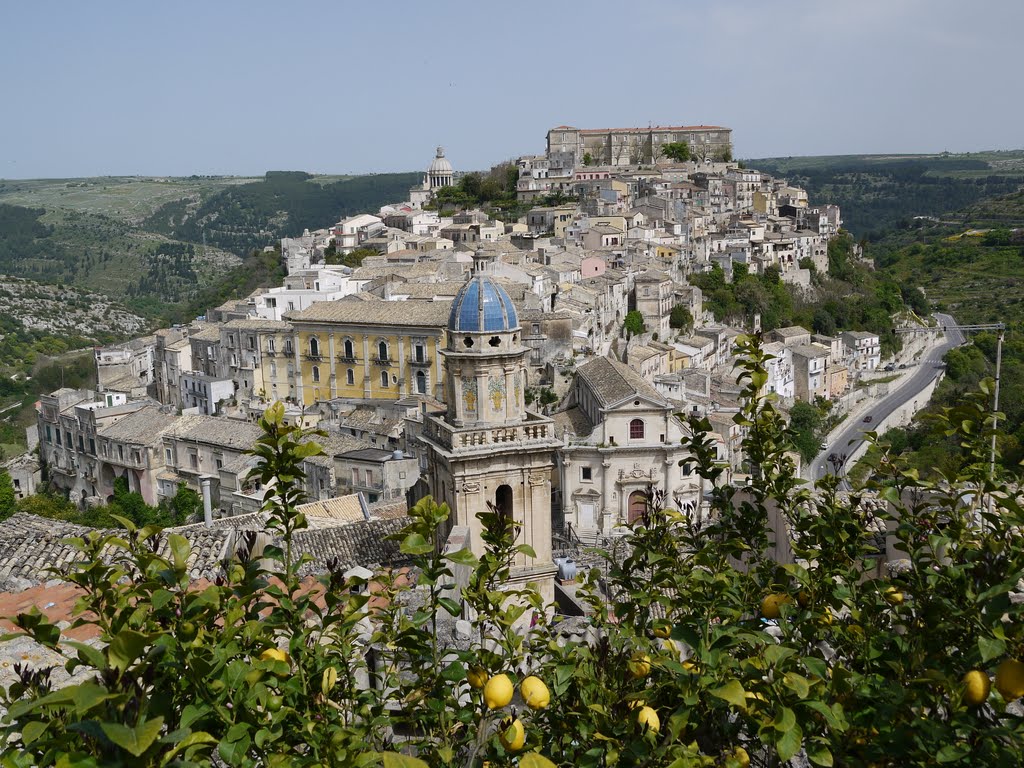About Ragusa
Ragusa is one of the most picturesque towns in Sicily. The view from the upper town over Ragusa Ibla on its own separate hilltop is quite breathtaking. One of the UNESCO-listed Baroque towns of south-eastern Sicily, Ragusa is also one of the principal filming locations for the Sicilian detective drama Il Commissario Montalbano (Inspector Montalbano), a series which has done wonders for publicising the beauty of this area. With a new airport at Comiso, ten miles away, due to open, this is a tourist destination which is definitely up and coming.
- Sicily destinations and practicalities: full menu (at foot of this page)
Ragusa is in the Monti Iblei, a large area of high ground, divided up by dry stone walls and incised with ravines. The town was originally built on a small steep-sided hill with deep valleys on three sides separating it from the high plateau. After the earthquake of 1693, which destroyed many of south-eastern Sicily’s buildings, it was decided to rebuild Ragusa on higher, more level ground nearby. This new planned town was built, with straight streets and a rational layout, but local aristocrats didn’t want to move, and instead built themselves new palazzi on the ruins of the old town. So nowadays Ragusa has two parts: Ibla (or Ragusa Ibla), the older nucleus on its hilltop, and Ragusa Superiore, the more modern upper town which spreads from the post-earthquake streets into more recent developments. Like all Sicilian towns, Ragusa has its share of ugly modern sprawl, but this is well away from the historic centre, which is remarkably unspoilt.
Ragusa Ibla is the magnet for tourists, though the upper town is still worth a visit. The bus and railway stations, the town’s archaeological museum and its everyday shops and businesses are in Ragusa Superiore as well as most of the hotels. Ibla is the more charming base for a holiday, though, with picturesque lanes, cafes, restaurants and gastronomic shops aimed at tourists. Its main artery is the perfect venue for the evening passeggiata.
What to see in Ragusa
The best activity in Ragusa is wandering; meandering along the character-filled lanes of Ragusa Ibla or clambering up the steps towards the upper town and enjoying the great, classic view over Ibla. This is an inviting town for even more leisurely pursuits – a long drink at a cafe table on the pretty sloping piazza in front of the Duomo, a wine-flavoured gelato, a splendid meal at one of the town’s small restaurants or a stroll in the park.
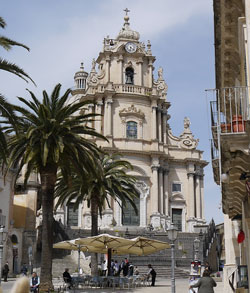
Like neighbouring towns, Ragusa was rebuilt after the great earthquake in the Baroque style, and its palazzi and churches are elegant and covered with a profusion of florid detail. The grandest building in Ibla is the cathedral, the Duomo di San Giorgio, begun in 1738 and designed by the architect Rosario Gagliardi. Up a flight of steps and segregated from the streets by ornate railings, this is the heart of the old town and contains some of its best, and most prized artworks. These include a statue of St. George which is carried around town in devout processions. Alongside the church is the small Museo del Duomo (open at weekends), a museum containing stone statues and reliefs from the original pre-earthquake San Giorgio and other churches, architectural drawings by Gagliardo, some extravagant reliquaries and gloomy religious paintings. One of the highlights is a nice little stone carving, from the 15th century, portraying a honey-maker (mielaio) with honeycomb and jug.
Ibla’s lanes contain many charms, from elaborately-sculpted balconies to views over the narrow valleys below town. If you have time, it’s a good place to explore, with some intriguing corners. A little tourist train (trenino) departs from Piazza Duomo and is an entertaining way of touring the principal streets.
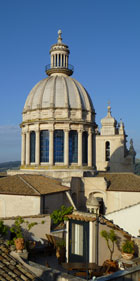
At the end of Ibla’s rocky ridge is the town’s public park, the Giardino Ibleo. The pride of the town, these manicured and leafy gardens have views over the surrounding valleys and are the venue of choice for promenading locals as well as tourists. Watching three or four generations meeting up and groups of teenagers strolling arm-in-arm is a charming introduction to Sicilian life.
As well as exploring Ibla, most visitors will want to take a look at Ragusa Superiore. The two towns meet at a saddle of land marked by the small Piazza della Repubblica. One of the town’s tourist offices is alongside, and also the attractive Chiesa delle Anime del Purgatorio. The upper town can be reached by an energetic climb or by the little local bus from the Giardino Ibleo or Piazza della Repubblica.
Ragusa Superiore is more than just the ‘modern’ part of town – it too boasts elegant streets and noble palazzi. It also has its own Duomo, the Cattedrale di San Giovanni Battista, another eighteenth-century Baroque edifice. The main street, Corso Italia, which descends towards Ibla, is lined with attractive buildings. However, there is no denying that the best part of the upper town is the descent, via flights of steps or the winding road, towards Ibla, with the hilltop town spread out before the eyes in an unforgettable panorama.
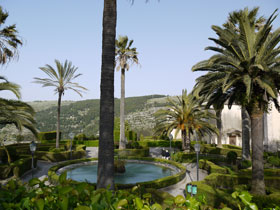
For any traveller interested in Sicily’s history, Ragusa’s archaeological museum (Museo Archeologico) is a must. Situated in Ragusa Superiore, this museum contains some fascinating and important exhibits from the surrounding area. Interesting artefacts include an articulated doll with moving joints from a child’s grave at Greek Kamarina, and the sculpture of a warrior known as the Guerriero di Castiglione. It’s a bit off the tourist trail; we were the only visitors, our arrival surprising the chatting attendants. The museum is just off Via Roma – at a lower level, down steps from the main street – and there’s an admission charge.
Between July and September the area is enlivened by the Estate Iblea, a summer festival of music and events around Ragusa. In October Ibla hosts a festival of busking and street entertainment, called Ibla Buskers. Other colourful events during the year in Ragusa include Easter and St. George’s Day processions.
Eating and drinking
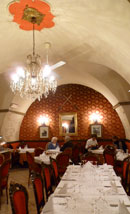
My favourite Ragusa restaurant was La Rusticana (Corso 25 Aprile, 68), a small place with friendly staff serving local and Sicilian food – all the classics, from local antipasti through fettucine alla Norma to cassata for dessert. The charming interior features red and gold velvet wallpaper, a chandelier, crossed swords and scrawled autographs on the wall – the restaurant is a significant Montalbano location, standing in for the detective’s ‘Trattoria San Calogero’ and the cast of the series have left their mark. Book ahead. Another good spot is the family-run Cucine e Vino (Via Orfanotrofio, 91) with a restrained atmosphere in a stone-vaulted and white-plastered interior, offering thoughtful local cuisine. For a quick no-frills meal, visit Il Gattopardo, (via Orfanotrofio, 35) a friendly little tavola calda where you can join Italian families eating pizza slices, focaccia and the local stuffed-bread scacce at little tables inside or out.
One of the most picturesque places for a drink is at the outdoor tables of Caffe Al Borgo in Piazza Duomo. Close by is the most popular gelateria in the region, Gelati DiVini, renowned for its special ice-cream flavours such as wines and olive oil. Ibla’s tourist shops are mostly of the speciality-food type, and food-loving visitors can spend happy hours browsing, sampling and shopping.
Around Ragusa
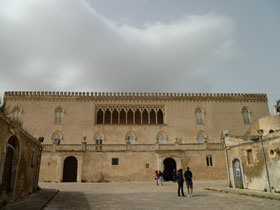
One of the best sights in the Ragusa area is the Castello di Donnafugata, a pseudo-Venetian-Gothic country villa in the countryside. In Montalbano this festures as the home of retired Mafia boss Balduccio Sinagra. The building is a strange blend of influences, mostly dating to the late nineteenth and early twentieth centuries. Reachable by car, taxi and very occasional trains, this grand country villa is a fascinating insight into the lives of the Sicilian aristocracy. With a garden to explore and some country paths starting outside the entrance, it’s also a good chance to get out into the open spaces of this rather striking landscape. There are a handful of places to eat and drink outside the entrance to the villa. Donnafugata is closed on Mondays and opening hours vary throughout the year; check the latest times before you make your trip (see links panel).
Donnafugata is a popular day out in the Ragusa area; another is the seaside – local seaside resort Marina di Ragusa and fishing village Punta Secca (another Montalbano location) are connected to Ragusa by bus.
The other Baroque towns of Sicily are within easy reach of Ragusa. It’s possible to explore by public transport, although travellers should check timetables when making plans. We toured the area, spending nights in different towns, but it is also possible to make day trips from Ragusa. Modica, another dramatic town, is the nearest and easiest to visit. Famous for its chocolate as well as its Baroque architecture, it’s a town well worth a visit. The archaeological site of Cava d’Ispica, a green valley lined with rock-cut tombs, is easy to reach by car. Noto and Scicli are two more sights worth seeing.
Travel to Ragusa
If and when it opens for international flights, the airport at Comiso, ten miles away, will be the obvious choice for visiting Ragusa. Catania Airport is the nearest major airport, with international flights. There are direct buses between Catania Airport and Ragusa, a journey which takes just one hour and forty-five minutes.
Ragusa has both a bus and a railway station in the modern part of the upper town. Bus connections are generally more efficient and practical. Buses operated by various companies connect Ragusa with other Sicilian towns; AST run to Modica, Scicli, Noto and Siracusa, and Etna Trasporti operate services to Catania Airport. Modica is thirty minutes away, on the same bus route which continues to Siracusa. Tumino operate a local service to the seaside, stopping at Marina di Ragusa, Punta Secca and Kamarina. Ragusa is at the end of the railway line connecting Siracusa with the other Baroque towns – in the summer, look out for special excursions on the ‘Treno del Barocco’. Useful information on buses can be found on the website of Ragusa council (comune), listed in the right-hand links panel. The best way to reach Ibla from the bus and railway stations is by catching the little local bus which connects Ragusa Superiore with the public gardens in Ibla. A timetable for this service can be found on the comune website, under Linea Urbana. Local bus tickets can be bought from some tabacchi shops in Ibla; longer-distance bus tickets can be bought at a kiosk at the bus station (for some companies) and around the corner at a bar on Via Teocrito.
There are signposted car parks in several points outside Ibla. The principal car parking (with a fee) is in the valley below Piazza della Repubblica and Ibla. There is also car parking by the Giardino Ibleo.
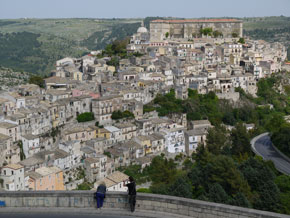
Ragusa accommodation
Where to stay in Ragusa will depend largely on your taste and on hotel availability. Ibla is a charming place to wander, particularly in the evenings when restaurants are inviting. Staying in Ragusa Superiore will mean a stiff walk or a bus ride when you head across to Ibla, but the upper town does have a larger selection of hotels and offer plenty of amenities. We stayed in Hotel Il Barocco, a very conveniently-located hotel in Ibla, near the public gardens and bus stop. The hotel confused my reservation, forcing me to change rooms during my stay, but in other respects offered decent accommodation.
> Hotel Il Barocco.
Other options include:
> The four-star Antica Badia Relais, an elegant five-star hotel on the main street of Ragusa Superiore
> San Giorgio Palace, a four-star in Ibla.
> B&B Orto sul Tetto, a B&B in Ibla
> L’Apparthotel – self-catering apartments on the edge of Ibla, for a more independent stay.
> Availability search for Ragusa hotels, B&Bs & apartments
Highlights
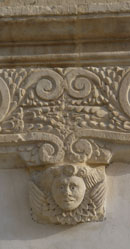
Inspector Montalbano on the BBC
Useful external links
Ragusa hotels, B&Bs & apartments
Castello di Donnafugata opening hours
Etna Trasporti (Catania Airport bus)
